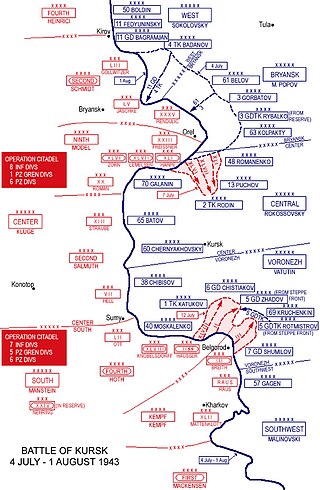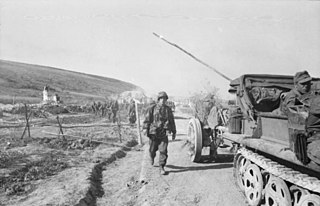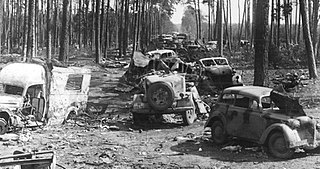
The Battle of Kursk was a major World War II Eastern Front large-scale engagement between the forces of Nazi Germany and the Soviet Union near Kursk in southwestern Russia during the late summer of 1943; it ultimately became the largest tank battle in history and resulted in a Soviet victory.

The Battle of Berlin, designated as the Berlin Strategic Offensive Operation by the Soviet Union, and also known as the Fall of Berlin, was one of the last major offensives of the European theatre of World War II.

The Third Battle of Kharkov was a series of battles on the Eastern Front of World War II, undertaken by Army Group South of Nazi Germany against the Soviet Red Army, around the city of Kharkov between 19 February and 15 March 1943. Known to the German side as the Donets Campaign, and in the Soviet Union as the Donbas and Kharkov operations, the German counterstrike led to the recapture of the cities of Kharkov and Belgorod.

Operation Citadel was the German offensive operation in July 1943 against Soviet forces in the Kursk salient, proposed by Generalfeldmarschall Fritz Erich Georg Eduard von Manstein during the Second World War on the Eastern Front that initiated the Battle of Kursk. The deliberate defensive operation that the Soviets implemented to repel the German offensive is referred to as the Kursk Strategic Defensive Operation. The German offensive was countered by two Soviet counter-offensives, Operation Polkovodets Rumyantsev and Operation Kutuzov. For the Germans, the battle was the final strategic offensive that they were able to launch on the Eastern Front. As the Allied invasion of Sicily began, Adolf Hitler was forced to divert troops training in France to meet the Allied threats in the Mediterranean, rather than use them as a strategic reserve for the Eastern Front. Germany's extensive loss of men and tanks ensured that the victorious Soviet Red Army enjoyed the strategic initiative for the remainder of the war.

Operation Bagration was the codename for the 1944 Soviet Byelorussian strategic offensive operation, a military campaign fought between 22 June and 19 August 1944 in Soviet Byelorussia in the Eastern Front of World War II, just over two weeks after the start of Operation Overlord in the west, causing Nazi Germany to have to fight on two major fronts at the same time. The Soviet Union destroyed 28 of 34 divisions of Army Group Centre and completely shattered the German front line. It was the biggest defeat in German military history, with around 450,000 German casualties, while 300,000 other German soldiers were cut off in the Courland Pocket.

The Battle of Halbe was a battle lasting from April 24 – May 1, 1945 in which the German Ninth Army—under the command of General Theodor Busse—was destroyed as a fighting force by the Red Army during the Battle of Berlin.

The Vistula–Oder offensive was a Red Army operation on the Eastern Front in the European theatre of World War II in January 1945. The army made a major advance into German-held territory, capturing Kraków, Warsaw and Poznań. The Red Army had built up their strength around a number of key bridgeheads, with two fronts commanded by Marshal Georgy Zhukov and Marshal Ivan Konev. Against them, the German Army Group A, led by Colonel-General Josef Harpe, was outnumbered five to one. Within days, German commandants evacuated the concentration camps, sending the prisoners on their death marches to the west, where ethnic Germans also started fleeing. In a little over two weeks, the Red Army had advanced 480 kilometres (300 mi) from the Vistula to the Oder, only 69 kilometres (43 mi) from Berlin, which was undefended. However, Zhukov called a halt, owing to continued German resistance on his northern flank (Pomerania), and the advance on Berlin had to be delayed until April.

The Battle of the Seelow Heights was part of the Berlin Strategic Offensive Operation. A pitched battle, it was one of the last assaults on large entrenched defensive positions of the Second World War. It was fought over three days, from 16–19 April 1945. Close to 1,000,000 Soviet soldiers of the 1st Belorussian Front, commanded by Marshal Georgy Zhukov, attacked the position known as the "Gates of Berlin". They were opposed by about 110,000 soldiers of the German 9th Army, commanded by General Theodor Busse, as part of the Army Group Vistula.

The Lvov–Sandomierz offensive or Lvov–Sandomierz strategic offensive operation was a major Red Army operation to force the German troops from Ukraine and Eastern Poland. Launched in mid-July 1944, the operation was successfully completed by the end of August.

The Battle of the Oder–Neisse is the German name for the initial (operational) phase of one of the last two strategic offensives conducted by the Red Army in the Campaign in Central Europe during World War II. Its initial breakthrough phase was fought over four days, from 16 April until 19 April 1945, within the larger context of the Battle of Berlin. The Soviet military planners divide the frontal and pincer phases of the operation, named Berlin Strategic Offensive Operation into:

The Second Battle of Târgu Frumos was a military engagement primarily between the Wehrmacht and Red Army forces in May 1944, near Iași, Romania. The battle was the main engagement of the Târgu Frumos Operation, and is often referred simply as the Battle of Târgu Frumos.
The Battle of Memel or the siege of Memel was a battle which took place on the Eastern Front during World War II. The battle began when the Red Army launched its Memel offensive operation in late 1944. The offensive drove remaining German forces in the area that is now Lithuania and Latvia into a small bridgehead in Klaipėda (Memel) and its port, leading to a three-month siege of that position.

The Lublin–Brest Offensive was a part of the Operation Bagration strategic offensive by the Soviet Red Army to clear the Nazi German forces from the regions of Eastern Poland and Western Belarus. The offensive was executed by the left (southern) wing of the 1st Belorussian Front and took place during July 1944; it was opposed by the German Army Group North Ukraine and Army Group Centre.

The East Pomeranian strategic offensive operation was an offensive by the Soviet Red Army against the German Wehrmacht on the Eastern Front. It took place in Pomerania and West Prussia from 10 February – 4 April 1945.

The Minsk offensive was part of the second phase of the Belorussian strategic offensive of the Red Army in summer 1944, commonly known as Operation Bagration.
Operation Solstice, also known as Unternehmen Husarenritt or the Stargard tank battle, was one of the last German armoured offensive operations on the Eastern Front in World War II.
The Lower Silesian offensive was a Soviet offensive on the Eastern Front of World War II in 1945, involving forces of the 1st Ukrainian Front under Marshal Ivan Konev. It cleared German troops from much of Lower Silesia and besieged a large German force in the provincial capital, Breslau. The offensive began on February 8 and continued until February 24, when the Soviets ceased their offensive having captured a small bridgehead across the Neisse River near Forst. The offensive directly succeeded the Vistula–Oder offensive, in which Konev's troops had driven the German Army Group A from Poland, liberating Kraków and taking bridgeheads over the Oder.
The 61st Rifle Corps was a Red Army infantry corps during World War II, formed twice. The 61st Rifle Corps was formed firmed in Tula during September 1939. After Operation Barbarossa, it was transferred to the front in Belarus and fought in the Battle of Smolensk. After suffering heavy losses at Smolensk, it was disbanded in early August 1941. Reformed in spring 1943, the corps fought in Operation Kutuzov, the Lublin–Brest Offensive and the Berlin Offensive. The corps was disbanded after the end of the war in summer 1945.
The 26th Guards Rifle Division was reformed as an elite infantry division of the Red Army in April, 1942, based on the 1st formation of the 93rd Rifle Division, and served in that role until after the end of the Great Patriotic War. It would soon after provide the headquarters cadre for the 8th Guards Rifle Corps. It was soon assigned, with its Corps, to 20th Army of Western Front and saw extensive fighting, while also suffering extensive casualties, in two campaigns against the German 9th Army in the Rzhev salient through the rest of 1942. The division, again with 8th Guards Corps, joined the 11th Guards Army when it was formed in April, 1943 and, apart from a brief reassignment in early 1944, remained under those commands for the duration of the war. During that summer the division took part in the liberation of Bryansk. By December, after fighting through western Russia north of Smolensk it was in 1st Baltic Front, attacking south towards Gorodok and won the name of that city as a battle honor. By the start of the offensive against Army Group Center in the summer of 1944 the 26th Guards had been redeployed with its Army to the south of Vitebsk as part of 3rd Belorussian Front, where it would remain for the duration. Driving westward during Operation Bagration the division advanced north of Orsha and then helped to seize a crossing over the Berezina River for which it was awarded the Order of the Red Banner. It continued to advance through Lithuania to the border with East Prussia later that year. As part of the East Prussian Offensive the 26th Guards entered that heavily fortified region in the winter of 1945 and helped gradually break the German resistance there, particularly at Insterburg and Königsberg, winning the Order of Suvorov for its part in the battle for the former place. The division ended the war at Pillau. The 26th Guards remained in the Kaliningrad Oblast well after the war, becoming the 26th Guards Motorized Rifle Division in 1957 and not finally disbanded until 1989.
The 222nd Rifle Division was an infantry division of the Red Army, originally formed in the months just before the start of the German invasion, based on the shtat of September 13, 1939. It was formed at Starodub and was considered a "sister" to the 217th Rifle Division. It first saw action in July 1941 as part of 28th Army in the fighting between Smolensk and Roslavl and the division took heavy casualties when it was partly encircled and forced to abandon the latter city in early August. It was again encircled during Operation Typhoon but managed to escape complete destruction and soon came under command of 33rd Army, where it remained for almost the entire length of the war.












